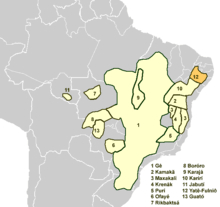Fulniô language
Fulniô, or Yatê, is a language isolate of Brazil, and the only indigenous language remaining in the northeastern part of that country. The two dialects, Fulniô and Yatê, are very close. The Fulniô dialect is used primarily during a three-month religious retreat. Today, the language is spoken in Águas Belas, Pernambuco.[3]
| Yatê-Fulniô | |
|---|---|
| Native to | Brazil |
| Region | Águas Belas, Pernambuco |
Native speakers | 1,000 (2011)[1] |
Macro-Gê?
| |
| Dialects |
|
| Language codes | |
| ISO 639-3 | fun |
| Glottolog | fuln1247[2] |
 | |
The language is also called Carnijó, and alternate spellings are Fornió, Furniô, Yahthe, and Iatê.
Classification
Kaufman (1990) classified Fulniô as one of the Macro-Gê languages. However, Eduardo Ribeiro of the University of Chicago, who is working on large-scale classification of Brazilian languages, finds no evidence to support this, and treats it as an isolate.
Phonology
| Labial | Alveolar | Postalveolar | Palatal | Velar | Glottal | |||||||
|---|---|---|---|---|---|---|---|---|---|---|---|---|
| plain | aspirated | plain | lateralized | aspirated | plain | aspirated | plain | aspirated | ||||
| Stop | voiceless | p | pʰ | t | tʰ | k | kʰ | (ʔ) | ||||
| voiced | d | |||||||||||
| Affricate | voiceless | t͡s | t͡sʰ | t͡ʃ | t͡ʃʰ | |||||||
| voiced | d͡ʒ | |||||||||||
| Fricative | voiceless | f | s | ʃ | h | |||||||
| voiced | z | |||||||||||
| Nasal | m | n | ||||||||||
| Approximant | l | j | w | |||||||||
The glottal stop [ʔ] is considered epenthetic.
| Front | Back | |
|---|---|---|
| Close | i | u |
| Near-close | ɪ | o |
| Open-Mid | ɔ | |
| Near-open | æ | |
| Open | a |
There are few contrasts between /o/ and /u/, suggesting /u/ is a recent addition, perhaps from Portuguese.
All seven have nasalized and glottalized allophones, depending on adjacent consonants. Vowels occur long and short. However, long vowels result from assimilation of /h/, are pronounced [Vh] in one dialect, and so are analyzed as /Vh/ sequences.
Tones are high and low. Contour tones occur allophonically adjacent to voiced consonants. Final syllables tend to lack a tone contrast, and final vowels may be devoiced or dropped.
There are no vowel sequences; vowels either coalesce or are separated by a glottal stop. Consonant clusters are limited to two consonants, apart from a possible additional /j w/, with the maximum syllable being CCCVC; reduced vowels between consonants are analyzed as /j w/ by Meland & Meland: /tfàltʰùlkja/ 'crossing over', /kwlèlja/ 'rotten'.
Vocabulary
Loukotka (1968)
Loukotka (1968) lists the following basic vocabulary items.[4]
gloss Fulnio head i-tká eye itó tooth dzyashi foot ishiri water oya fire toːwẽ star tiúyá maize malchi jaguar kléken black chichiá
Nikulin (2020)
Some Yaathê words given by Nikulin (2020),[5]:69–70 cited from Lapenda (1965,[6] 2005 [1968][7]), Barbosa (1991),[8] Costa (1999),[9] F. Silva (2011a,[10] 2011b[11]), and Branner (1887).[12]
Portuguese gloss
(original)English gloss
(translated)Yaathê cinza ashes fêlôwa pé foot fêhê folha leaf ta(-)cʰa fígado liver ta(-)cô dente tooth ta(-)xi cabelo hair li água water ôːja língua tongue kts(ʰ)ale boca mouth ta(-)tʰê nariz nose kʰletʰa olho eye tʰô orelha ear kfakê cabeça head tkʰa fogo fire tôwê árvore tree cʰleka semente seed kêtʰôja ouvir hear kfala- dormir sleep kfafa- terra earth fê(j)ʔa piolho louse cfôwa pedra stone fô(ʔ)a chuva rain flicja mão hand koho ~ kʰoja (?) caminho road tdi dar give kô- estar sentado be seated kine- estar deitado lying down kʰa- ir go o-, no- rabo tail ta(-)tô carne meat ucʰi ~ utxi nome name ketkʲa unha nail (finger) kʰôtkʲa
Bibliography
- Fulniô (Yahthe) Syntax Structure, Meland & Meland (2009 [1968])
- Phonemic Statement of the Fulniô Language, Meland & Meland (2010 [1967])
References
| Wiktionary has a word list at Appendix:Yatê word list |
- Yatê-Fulniô at Ethnologue (19th ed., 2016)
- Hammarström, Harald; Forkel, Robert; Haspelmath, Martin, eds. (2017). "Fulniô". Glottolog 3.0. Jena, Germany: Max Planck Institute for the Science of Human History.
- Ethnologue
- Loukotka, Čestmír (1968). Classification of South American Indian languages. Los Angeles: UCLA Latin American Center.
- Nikulin, Andrey. 2020. Proto-Macro-Jê: um estudo reconstrutivo. Tese de Doutorado em Linguística, Universidade de Brasília.
- Lapenda, G. C. Perfil da lingua yathê. Arquivos, Recife, v. 21/47, p. 54–72, 1965.
- Lapenda, G. C. Estrutura da língua Iatê, falada pelos índios Fulniôs em Pernambuco. 2ª ed. Recife: Editora Universitária UFPE, 2005 [1968]. 277 pp.
- Barbosa, E. A. Aspectos fonológicos da língua Yatê. 1991. 55 pp. Dissertação (Mestrado em Linguística) – Departamento de Lingüística, Línguas Clássicas e Vernácula, Instituto de Letras, Universidade de Brasília. 1991.
- Costa, J. F. da. Yaːthê, a última língua nativa no Nordeste do Brasil: aspectos morfo-fonológicos e morfo-sintáticos. 1999. 365 pp. Tese (Doutorado em Linguística) – Universidade Federal de Pernambuco. 1999.
- Silva, F. P. da. A sílaba em Yaathe. Dissertação (Mestrado em Linguística) – Faculdade de Letras, Universidade Federal de Alagoas, 2011a. 133 pp.
- Silva, F. P. da. Descrição da estrutura silábica do Yaathe, uma língua indígena brasileira. In: Anais do VII Congresso Internacional da Abralin. Curitiba: s./ed., 2011b. p. 1378–1389.
- Branner, J. C. Os Carnijós de Aguas Bellas [Notas sobre uma língua indigena brasilieira]. Revista do Instituto Historico e Geographico Brasileiro, Rio de Janeiro, v. 94, n. 148, p. 359–365, 1929.